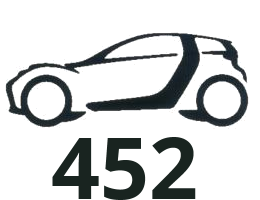Mod Description
An official lab tested the smart turbo to determine why it crackedMod Details
PremiumNo Difficulty



 Mod ID728
CreditPresspley
For
Mod ID728
CreditPresspley
For
 Linkhttps://www.evilution.co.uk/mod/presspley-crack-investigation.htm Copy to Clipboard
Linkhttps://www.evilution.co.uk/mod/presspley-crack-investigation.htm Copy to ClipboardIn 2004, a disappointed smart customer sent their cracked turbo off to Presspley for analysis. Presspley.com was an Australian company who specialised in simulation and analysis. The investigation was interesting but disappeared when Presspley went bust. So here it is again in all its glory (with some of the poor English and grammar sorted).
Failure Investigation Of Smart Car Exhaust Manifold Turbocharger Unit
Dated 24/10/04
Contents
Introduction
Visual lnspection
Micro-examination
Tensile Test
Chemical Analysis
Discussion
Conclusion
Photographs
Introduction
The fuel economy of a Smart Pulse, was found to be dropping from a typical 66mpg to around 40mpg, with no difference in vehicle use. Having reported this to his local Smart Centre, and have them try to find the problem, no problems were found.
At a later date after the car had run out of warranty but with the same problem still persisting, the vehicle was serviced at a Mercedes Benz dealer. The exhaust manifold/turbocharger unit was found to be cracked in two places.
Visual Inspection
The Smart car manifold unit has had a considerable number of redesigns. The unit being investigated is a Garrett GT12 turbo with part number: A 160 096 0599 Other numbers etched onto the in flange are: 000 T926 V001
The manifold/turbo was received in the as removed condition. The unit appeared to be in good condition except for the two large cracks in between the 3 cylinders. The extent of the cracking can be seen in the photographs.
Micro-Examination
Cross-sectional specimens were cut from the sample and mounted in metallographic moulds. These were then progressively ground before final polishing with 0.05mm colloidal silica suspension, to give a scratch-free surface and reveal the true grain structure.
These were viewed in the as-polished condition first, then etched and viewed again at magnifications up to x1000. Etching to a satisfactory level was carried out by swabbing the polished surface with 5% Nital solution.
The microstructure was that of a Ni-Resist cast iron. Porosity was noticed throughout the section of the casting, however it is not considered to be excessive.
Tensile Testing
A round tensile specimen was machined from the manifold and tested using an lnstron 5582 tensile testing machine. Results are shown below.
0.2% Proof stress (MPa) = 251
UTS (MPa) = 467
Elongation (%) = 16.5
Chemical Analysis
A sample was tested using the Optical Emission Spectroscopy method. Results can be seen in the table below.
Carbon, C = 2.10
Silicon, Si = 3.98
Manganese, Mn = 0.581
Nickel, Ni = 34.065
Copper, Cu = 0.086
Chromium, Cr = 1.852
Sulphur, S = 0.002
Molybdenum, Mo = 0.125
This is a typical composition of a Ni-Resist cast iron.
Conclusion
Mechanical properties appear typical of those expected for a cast Nickel-alloy. The chemical composition is similar to that of a Ni-Resist cast iron. Type 1 Ni-Resist should not be used in applications involving service above 1300° F (430° C).
Austenitic alloys may be softened and homogenized by heating to 1800-1900° F (980-1040°C) for 3 to 5 hours and air-cooling. This breaks down some of the carbides and most of those remaining will be spheroidised.
lf the car was driven under load for 3-5 hours causing exhaust temperatures to become very hot, then the engine left to cool; heat treatment mechanisms could have taken place. Thermal gradients across the manifold result in thermal shock, causing internal residual stresses which could have lead to crack initiation.
Some inter-dendritic shrinkage is evident in the vicinity of the cracking.
Cracks always propagate through a material following the weakest path, which is through the gaps between the shrinkage. Shrinkage is caused by poor casting design and technique. On inspection of the vehicle, it is noted that the replacement manifold/turbo is part number A 160 096 0699, which is a redesign and features additional material around the areas which cracked.
This suggests the cracking was caused by poor design, which is most likely being addressed on a case by case basis by Smart (UK) rather than recalling all the vehicles sold due to the cost involved.
Discussion
There are three factors that are generally causes for the problem, although no one is usually to blame alone – it is a combination of the three, in any percentage, that generates such cracks.
1) Mass of the turbo unit (and exhaust if hung off the turbocharger) with combined shock loading from undulating road surface not being fully considered.
2) Insufficient allowance for expansion of the material due to the intended design, method or deviation of manufacturing from that of the design of the manifold/ cylinder head fixings.
3) Incorrect material thickness to accommodate the expansion and contraction of the manifold based on the change of section of manifold, exhaust gas temperature within the manifold, and method of attaching to cylinder head.
Other factors, such as the material not meeting the required specification, whether at the design or manufacturing level, is yet another factor that cannot really be commented on. Incorrect ignition advance is one such example.
This problem used to be quite common, but it is very surprising that it is occurring on a modem vehicle. The use of modem computational analysis programmes such as Ansys that can calculate combined thermal and mechanical stresses should (with suitable safety factors) eliminate this – again assuming the turbocharger is manufactured correctly. from the appropriate material, that it is fitted and used according the OEM’s specification.
The cross section, together with the mounting arrangement is at fault – i.e. it is a design issue. Note that the cracks are propagating at the points around the manifold fixings. It appears all bolt holes are the same size also. I would expect a greater hole size in the fixings at either end of the manifold to allow the manifold and head to expand & contract relative to each other, maintaining its position with the centre studs.
This is even more apparent when you consider the temperature of the manifold is not consistent along its length. The end furthest from the turbine housing has one cylinders worth of exhaust gasses (and heat). The second cylinder experiences two cylinders worth, whilst the third has one cylinders worth but is closest to the compressor housing – the hottest part of any turbocharger.
Petrol engine manufacturers are faced with ever-tightening emissions regulations imposed by American. Japanese. and European legislation. To meet future HC and CO limits, and to improve fuel economy, automotive engine manufacturers are looking towards running air to fuel ratios near lambda = 1 for full load engine conditions.
Traditionally full load air I fuel conditions have been in the region of lambda = 0.9 to improve maximum engine power output and maintain engine durability. The excess fuel under these conditions has a cooling effect on the exhaust temperature and has allowed engines to be below 1000°C in exhaust temperature. The move towards lambda = 1 will remove this fuel cooling effect and will yield exhaust temperatures up to 1050°C.
Today’s turbochargers are designed and qualified for existing high temperature gasoline applications. This has been a delicate balance of design, material technology, and cost. The move to 1050°C exhaust temperatures has prompted the Garrett Turbocharging Group to redefine this balance for turbochargers.
Photographs
Photograph 1: Overall shot of Manifold/turbo. as received, with arrows highlighting cracks.

Close up of cracking.

Close up shot of crack 1, as received.

Close up shot of crack 2, as received.

Showing complete penetration to inner face of manifold at crack 1.

Showing complete penetration to inner face of manifold at crack 2.

x100 magnification micro-section in the as polished condition. Structure shows small graphite nodules with columnar cementite.



